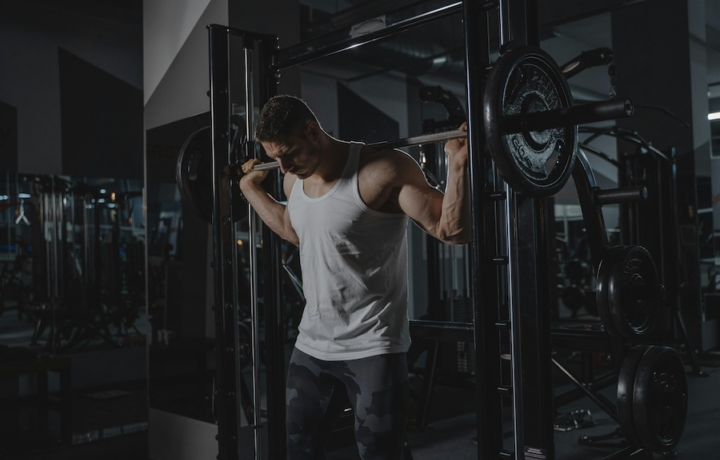Exercise
Crunch Floor

Crunch Floor
How to Perform
- Lie on your back with knees bent and feet flat on the floor about hip-width apart.
- Place your hands lightly behind your head with elbows pointing outward, avoiding pulling on your neck.
- Engage your core muscles by drawing your navel toward your spine while maintaining a natural curve in your lower back.
- Exhale as you lift your shoulder blades off the floor by contracting your abdominal muscles, keeping your lower back pressed into the mat.
- Focus on bringing your ribcage toward your pelvis rather than lifting your entire back off the floor.
- Hold the contracted position briefly at the top of the movement while maintaining tension in your abdominals.
- Inhale as you slowly lower your upper body back to the starting position, maintaining control throughout the descent.
- Keep your movements deliberate and controlled, avoiding momentum or jerking motions that could strain your neck or back.
Important information
- Keep your chin slightly tucked throughout the exercise to maintain proper neck alignment and prevent strain.
- Focus on quality over quantity—perform each repetition with proper form rather than rushing through the movement.
- Make sure your elbows stay wide and in your peripheral vision to prevent neck strain and ensure proper abdominal engagement.
- If you feel any discomfort in your lower back, decrease your range of motion or place your feet closer to your buttocks.

Crunch Floor
Exercise Details
Primary Muscles
Muscle Groups
Mechanic
Built for progress
Take the guesswork out of training
Create personalized AI-powered workout plans that evolve with you. Train smarter, track every rep and keep moving forward, one workout at a time.






The crunch floor is a fundamental abs exercise that delivers remarkable core engagement without the complexity of equipment or elaborate setups. As a staple in bodybuilding routines, recovery sessions, and warm-up sequences, this movement provides an accessible entry point for beginners while offering significant activation of the abdominal muscles when performed with proper technique. Working primarily on the rectus abdominis (the "six-pack" muscle) the crunch floor creates tension through a controlled spinal flexion that challenges your core stability.
Unlike full sit-ups, this exercise minimizes hip flexor involvement, allowing for more targeted abdominal work with reduced lower back strain, making it particularly suitable for those new to fitness. The beauty of the crunch floor lies in its versatility within a training program. For bodybuilders, it serves as a sculpting tool that defines the midsection when incorporated into hypertrophy-focused routines. During recovery phases, the controlled nature of the movement promotes blood flow to the abdominal region without overtaxing the central nervous system.
As a warm-up element, it activates the core musculature, preparing it for more demanding compound exercises that require trunk stability. What distinguishes an effective crunch floor from a mediocre one is the quality of the contraction. The exercise isn't about quantity but rather about creating meaningful tension through the abdominal wall with each repetition. This mindful approach transforms a seemingly simple movement into a powerful core developer that contributes to improved posture, enhanced athletic performance, and greater overall body awareness.
For beginners, the crunch floor provides an ideal foundation for core training, teaching fundamental bracing techniques and body control that transfer to more advanced abdominal exercises. As your strength develops, the movement can be progressively overloaded through increased repetitions, added resistance, or tempo manipulation, ensuring continued growth and development of your core strength.
FAQ - Crunch Floor
The crunch floor primarily targets the rectus abdominis (six-pack muscle) while minimizing hip flexor involvement compared to full sit-ups. Secondary engagement occurs in the obliques and transverse abdominis, making it an effective overall core developer.
Lie on your back with knees bent and feet flat on the floor, hands lightly supporting your head. Exhale as you curl your upper back off the floor by contracting your abs (not by pulling with your hands), then inhale as you slowly return to starting position while maintaining tension throughout.
Begin with 2-3 sets of 12-15 controlled repetitions, focusing on quality contraction rather than quantity. As you progress, you can increase to 3-4 sets of 15-20 reps, or add resistance by holding a weight plate on your chest for greater challenge.
The biggest mistakes include pulling on your neck with your hands, using momentum instead of muscle control, lifting too high off the floor, and rushing through repetitions. Focus on slow, controlled movements with deliberate abdominal contraction for maximum effectiveness.
The crunch floor is generally safer for the lower back than full sit-ups because it involves less spinal flexion. However, if you have existing back issues, maintain neutral pelvis position throughout the movement, avoid jerking motions, and consult with a healthcare provider before adding this exercise to your routine.






